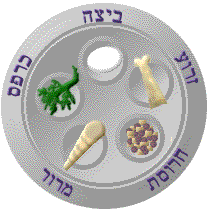Messiah and Passover
| Written by Glenn Kay |
 The Hebrew word used is - Pesach. Traditionally this word is translated from the verbal form - to spring, to jump or "Passover" hence our concept - Passover.
However - recently some have come to understand that the meaning of Pesach - does not so much imply - "Passover" - but rather - "Protect." Compare for instance - Isaiah 31:5
The Hebrew word used is - Pesach. Traditionally this word is translated from the verbal form - to spring, to jump or "Passover" hence our concept - Passover.
However - recently some have come to understand that the meaning of Pesach - does not so much imply - "Passover" - but rather - "Protect." Compare for instance - Isaiah 31:5
Key Themes
It is God's doing - Ex 12:11
It is Deliverance for His people - Ex 12:13,27
It is judgment on the gods of Egypt - Ex 12:12
- Nile - Ex 7:14-25 - Hapi - Nile deity
- Frogs - Ex 8:1-15 - Heqt - symbol of fertility
- Lice - Ex 8:16-19 - Seth - earth god
- Flies - Ex 8:20-32 - Ekron - flying creatures
- Livestock - Ex 9:1-7 - Apis (the sacred bull) / Hathor (cow goddess)
- Boils - Ex 9:8-12 - Sekmot - power to create epidemics and end them
- Hail - Ex 9:13-35 - Nut - sky goddess
- Locusts - Ex 10:1-11 - Isis/Seth - agricultural , crops
- Darkness - Ex 10:21-29 - Ra - considered by the Egyptians as one of the greatest of the deities
- Death of the Firstborn - Ex 11:1-10 - Pharaoh
How Long? Whom For?
For how long is the feast of Passover to be remembered?
- Exodus 12:14 - "throughout your generations...as a permanent ordinance."
- Exodus 12:17 - "throughout your generations...as a permanent ordinance."
- Notice the distinction that is made in Exodus 12:43-49
- Why this specific instruction?
- Notice the summation in : Ex 12:49
- Also consider - Numbers 9:14; 15:15-16
While in the wilderness, Passover became tied to, and celebrated with - the Feast of Unleavened Bread
According to God's instructions, the people were to at unleavened bread for seven days after Passover.
As such every year prior to Passover house cleaning takes place to remove any leavened products from the home.
Traditionally - the mother leaves some bread crumbs around the home:
Needed items: spoon, feather, and linen cloth
When found - the spoon is placed next to the crumbs and the feather is used for sweeping the crumbs into the linen cloth which is then put out of the house
What passage in the New Covenant is reflected in the ceremony? (I Cor. 5:7)
These are only used during the celebration of Passover and not any other time of the year.
This is to make sure that the dishes have never had any contact with leaven.
Changes made from Biblical Traditions
Addition of the cup for Elijah. This was added with the hope that Elijah would come and drink from the cup, and announce that Messiah has come (Mal 4:5)
Do you think this is a valid assumption? what of (Mat 11:14)?
Consider also (Mat 17:10-12)
The use of the - Matzah tash - with it's concept of the Echad:
- This is a special cloth holder with three sections to hold three pieces of Matzah.
- During the seder the middle one is broken in half - one half hidden away, the second returned to the Matzah tash.
- One of the names given to this holder is called the Echad - or unity
- Abraham, Isaac, Jacob
- The High Priest, the Levites, and Israel
- Do you agree with these - why or why not?
- What other options do you think these might represent?
- The other half of the second Matzah which was broken in to is wrapped in a linen cloth and hidden away for the children to find later in the meal.
- The word afikomen is a Greek word with some say means -"that which comes last". The Rabbis say it alludes to the fact that the affikomen is the last thing tasted at the seder, the dessert?
- What do you think?
- Still others say it means - "I have come". What would that be alluding to?
Rather than explaining the Messianic significance in aspects of the Seder - consider some things which are not covered in the Seder.
Triumphant Entry of the Lambs
During the first century, lamb was chosen by the High Priest outside Jerusalem on the 10th of Nisan.
The Priest would lead the lamb into the city while crows of worshippers lined the streets waving palm branches and singing the Hallal (Psalm 118).
It was son this day Yeshua entered Jerusalem (Jn. 12:9-19), probably right behind the High Priest's processional.
Inspection of the Passover Lamb
The High Priest would then take the lamb into the temple courtyard, where it would be tied in public view so to could be inspected for blemish.
For this reason, Yeshua came and sat in the temple courtyard - He was being inspected by the scribes and teachers of the Torah - in order to find fault - yet they could not.
The Lamb was to be for the household
God achieved redemption for each household in Israel through their lamb.
Yeshua is the Lamb by which we too are redeemed and become members of the household of Israel (Gal 6:10; Eph 2:19).
The Passover Lamb Was To Be Killed Between Evenings - Ex 12:6
"Between the evening" refers to that period of the day that goes from noon to 6:00 pm.
The exact middle of that time is 3:00 pm - this would be what Scripture calls the ninth hour of the day, counting from 6:00 am.
Which is when Yeshua was killed (Mat 27:45-50).